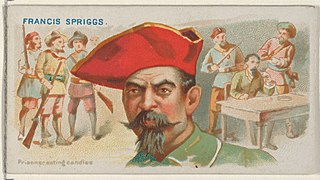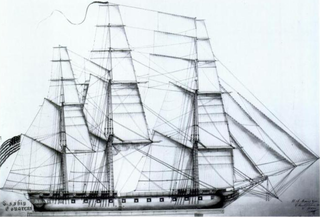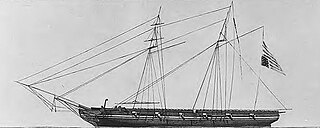Related Research Articles

Edward Teach, better known as Blackbeard, was an English pirate who operated around the West Indies and the eastern coast of Britain's North American colonies. Little is known about his early life, but he may have been a sailor on privateer ships during Queen Anne's War before he settled on the Bahamian island of New Providence, a base for Captain Benjamin Hornigold, whose crew Teach joined around 1716. Hornigold placed him in command of a sloop that he had captured, and the two engaged in numerous acts of piracy. Their numbers were boosted by the addition to their fleet of two more ships, one of which was commanded by Stede Bonnet, but Hornigold retired from piracy toward the end of 1717, taking two vessels with him.

Bartholomew Roberts, born John Roberts, was a Welsh pirate who was, measured by vessels captured, the most successful pirate of the Golden Age of Piracy. During his piratical career, he took over 470 prize ships. Roberts raided ships off the Americas and the West African coast between 1719 and 1722; he is also noted for creating his own pirate code, and adopting an early variant of the Skull and Crossbones flag.
Captain Benjamin Hornigold (1680–1719) was an English pirate who operated during the tail end of the Golden Age of Piracy.

Stede Bonnet was a Barbadian-born pirate and military officer, known as the Gentleman Pirate for the reason that he was a moderately wealthy landowner before turning to a life of crime. Bonnet was born into a wealthy English family on the island of Barbados, and inherited the family estate after his father's death in 1694. Despite his lack of sailing experience, Bonnet decided he should turn to piracy in the spring of 1717. He bought a sailing vessel, the Revenge, and travelled with his paid crew along the Eastern Seaboard of what is now the United States, capturing other vessels and burning other Barbadian ships.

Edward "Ned" Low was a notorious pirate of English origin during the latter days of the Golden Age of Piracy, in the early 18th century. Low was born into poverty in Westminster, London, and was a thief from an early age. He moved to Boston, Massachusetts, as a young man. His wife died in childbirth in late 1719. Two years later, he became a pirate, operating off the coasts of New England and the Azores, and in the Caribbean.

George Lowther was an English pirate who, although little is known of his life, was reportedly active in the Caribbean and Atlantic during the early 18th century. His First Mate was Edward Low.

Charles Vane was an English pirate who operated in the Bahamas during the end of the Golden Age of Piracy.

Richard Worley was a pirate who was active in the Caribbean Sea and the East Coast of the American Colonies during the early 18th century.

Francis Spriggs was a British pirate who, associated with George Lowther and Edward Low, was active in the Caribbean and the Bay of Honduras during the early 1720s.
Charles Harris (1698-1723) was an English pirate active in the 1720s. He is best known for his association with George Lowther and Edward Low.

The West Indies Squadron, or the West Indies Station, was a United States Navy squadron that operated in the West Indies in the early nineteenth century. It was formed due to the need to suppress piracy in the Caribbean Sea, the Antilles and the Gulf of Mexico region of the Atlantic Ocean. This unit later engaged in the Second Seminole War until being combined with the Home Squadron in 1842. From 1822 to 1826 the squadron was based out of Saint Thomas Island until the Pensacola Naval Yard was constructed.

John Martel was a French pirate active in the Caribbean.

The West Indies Anti-Piracy Operations were a series of military operations and engagements undertaken by the United States Navy against pirates in and around the Antilles. Between 1814 and 1825, the American West Indies Squadron hunted pirates on both sea and land, primarily around Cuba and Puerto Rico. After the capture of Roberto Cofresi in 1825, acts of piracy became rare, and the operation was considered a success, although limited occurrences went on until slightly after the start of the 20th century.
John Ireland was a pirate active in the Indian Ocean. He is best known for sailing with Thomas Tew.
Richard Shipton was a pirate active in the Caribbean, best known for sailing alongside Edward Low and Francis Spriggs. In 1723 Shipton was elected captain of Merry Christmas, and he subsequently captained ships such as Royal Fortune, York, and John and Mary. Forced to beach his vessel on western Cuba by pirate hunters, in early 1726, he was found ashore in his bed and presumed to have died shortly afterwards.

Philip Lyne was a pirate known for his cruelty and his association with Francis Spriggs.
James Allison was a pirate and former logwood hauler, active near Cape Verde and the Bay of Campeche. Almost the entire record of Allison's piracy comes from trial records of a single incident, the seizure of the merchantman Good Hope.
Brigstock Weaver was an English pirate active in the Caribbean. He is best known for his association with fellow pirates Thomas Anstis and Bartholomew Roberts.
Thomas Hawkins was a pirate briefly active off New England. He was known for sailing with Thomas Pound.

John Russell was a pirate active from Nova Scotia to the Caribbean to the African coast. He is best known for his association with Edward Low and Francis Spriggs, and for his involvement with two well-known and well-documented maroonings.
References
- 1 2 3 4 Watson, John Fanning (1830). Annals of Philadelphia: Being a Collection of Memoirs, Anecdotes, and Incidents of the City and Its Inhabitants, from the Days of the Pilgrim Founders...to which is Added an Appendix, Containing Olden Time Researches and Reminiscences of New York City. Philadelphia: E.L. Carey & A. Hart. p. 469. Retrieved 22 June 2017.
- 1 2 3 4 Gosse, Philip (1724). The Pirates' Who's Who. New York: Burt Franklin. Retrieved 22 June 2017.
- ↑ "The Pirate Surgeon's Journal: Golden Age of Piracy History of Pirate Surgeons Page 9". www.piratesurgeon.com. Retrieved 22 June 2017.
- ↑ Boyer, A. (1726). The Political state of Great Britain. London: A. Boyer. p. 641. Retrieved 22 June 2017.
- ↑ "Greg Flemming - America's Worst Pirates" . Retrieved 22 June 2017.
